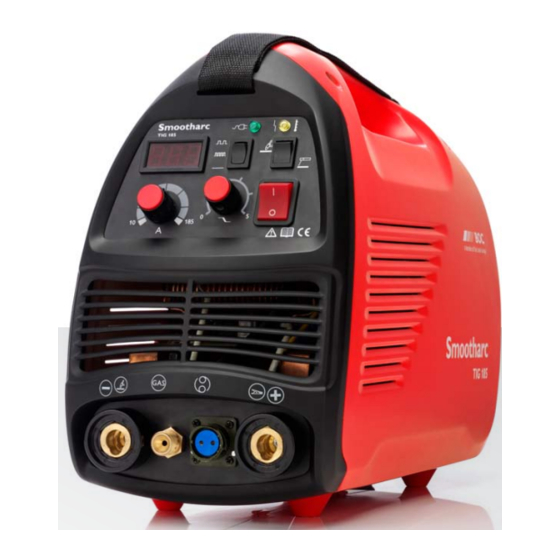BOC Smootharc TIG 185 DC Manual de instrucciones - Página 4
Navegue en línea o descargue pdf Manual de instrucciones para Sistema de soldadura BOC Smootharc TIG 185 DC. BOC Smootharc TIG 185 DC 15 páginas. Boc smootharc tig 185 dc welder
También para BOC Smootharc TIG 185 DC: Manual de servicio (19 páginas)

6
BOC Smootharc TIG 185 Operating Manual
1.3 Electrical shock
•
Never touch 'live' electrical parts
•
Always repair or replace worn or damaged parts
•
Disconnect power source before performing any
maintenance or service
•
Earth all work materials
•
Never work in moist or damp areas
Avoid electric shock by:
•
Wearing dry insulated boots
•
Wearing dry leather gloves
•
Never changing electrodes with bare
hands or wet gloves
•
Never cooling electrode holders in water
•
Working on a dry insulated floor where possible
•
Never hold the electrode and holder
under your arm
1.4 User responsibility
•
Read the Operating Manual prior to installation of
this machine
•
Unauthorised repairs to this equipment may
endanger the technician and operator and will
void your warranty. Only qualified personnel
approved by BOC should perform repairs
•
Always disconnect mains power before
investigating equipment malfunctions
•
Parts that are broken, damaged, missing or worn
should be replaced immediately
•
Equipment should be cleaned periodically
BOC stock a huge range of personal protective
equipment. This combined with BOC's extensive
Gas and Gear network ensures fast, reliable service
throughout the South Pacific.
PLEASE NOTE that under no circumstances should
any equipment or parts be altered or changed in
any way from the standard specification without
written permission given by BOC. To do so, will void
the Equipment Warranty.
Further information can be obtained from Welding
Institute of Australia (WTIA) Technical Note No.7.
Health and Safety Welding
Published by WTIA,
PO Box 6165 Silverwater NSW 2128
Phone (02) 9748 4443
2.0 Gas tungsten arc welding (GTAW/TIG)
2.1 Introduction
The Tungsten Inert Gas, or TIG process, uses the
heat generated by an electric arc struck between
a non-consumable tungsten electrode and the
workpiece to fuse metal in the joint area and
produce a molten weld pool. The arc area is
shrouded in an inert or reducing gas shield to
protect the weld pool and the non-consumable
electrode. The process may be operated
autogenously, that is, without filler, or filler may be
added by feeding a consumable wire or rod into the
established weld pool.
2.2 Process
Schematic of the TIG welding process
1
Shielding gas
2
Arc
3
TIG filler rod
4
Weld pool
5
Collet
6
Tungsten electrode
7
Workpiece
5
1
6
2
3
4
7
BOC Smootharc TIG 185 Operating Manual
Direct or alternating current power sources with
constant current output characteristics are normally
employed to supply the welding current. For DC
operation the tungsten may be connected to either
output terminal, but is most often connected to the
negative pole. The output characteristics of the
power source can have an effect on the quality of
the welds produced.
Shielding gas is directed into the arc area by the
welding torch and a gas lens within the torch
distributes the shielding gas evenly over the
weld area. In the torch the welding current is
transferred to the tungsten electrode from the
copper conductor. The arc is then initiated by one
of several methods between the tungsten and the
workpiece.
7
